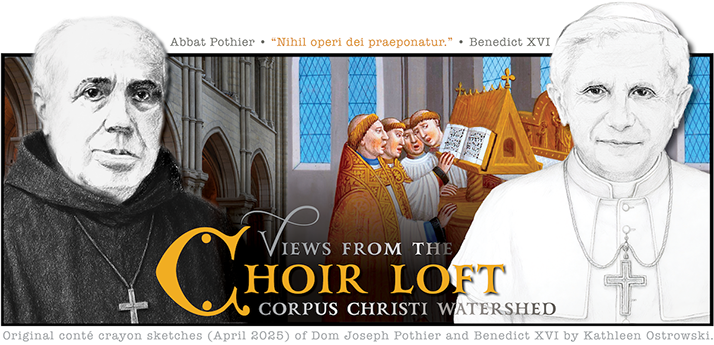 ITH VESPERS THIS SATURDAY, the Church begins Passiontide, the last two weeks of Lent. It is fitting for us to reflect on what is arguably the most beloved of all Catholic Lenten hymns, “At the Cross Her Station Keeping.” The commonly sung version appears in the St. Jean de Brébeuf Hymnal as follows:
ITH VESPERS THIS SATURDAY, the Church begins Passiontide, the last two weeks of Lent. It is fitting for us to reflect on what is arguably the most beloved of all Catholic Lenten hymns, “At the Cross Her Station Keeping.” The commonly sung version appears in the St. Jean de Brébeuf Hymnal as follows:

Along with the same version (but in the key of G), an alternative is given in the 1939 Westminster Hymnal:

Some hymnals omit the fermata, double bar line, or breath mark (luftpause) at the end of each phrase, and some parishes actually sing it that way, cutting those notes slightly short rather than lengthening them. Another common variant is a dotted antepenultimate note:

The above image is from the 1958 Service Book and Hymnal of the Lutheran Church in America. The text and melody appear not only in Catholic and Lutheran collections, but also Anglican, Methodist, Presbyterian, and other Protestant hymnals. I won’t examine all of the textual variants but would like to note that the translation beginning “At the Cross Her Vigil Keeping” is also widely used.
Liturgical AND Devotional • Most Catholic church musicians are aware that the Stabat Mater is one of only a handful of sequences retained in the Roman Missal. I was quite surprised to learn that it was not included in the Missal of Pope St. Pius V following the Council of Trent but was only restored by Pope Benedict XIII in 1727 for the feast of the Seven Sorrows of the Blessed Virgin Mary observed on the Friday after Passion Sunday and later extended to the second feast on September 15. For Stations of the Cross, all but six of the twenty stanzas are typically sung: one after each of the fourteen traditional stations. Thus we have a liturgical hymn with a true plainsong melody and a devotional version of the same hymn employing a later tune derived from the 1661 Mainz Gesangbuch (Mäyntzisch Gesangbuch) but erroneously called “plainsong” in various sources. Here is the beginning of the sequence from the 1908 Graduale Romanum:

An Isometric Variant • Other than the last example, the versions above show an isometric chorale tune. The Solesmes Liber Usualis notates the same melody as equalist plainsong, complete with ictus marks:

In fact, if the 1661 Mainz Gesangbuch is truly the source, this tune is not plainsong at all, nor are the notes of equal value. Here is the presumed original:

and a modernized version of the same:

An audio recording (organ) is available here. It is apparent that the version in common use, while still recognizable as the same tune, makes substantial changes to both melody and rhythm. I see nothing objectionable about retaining the customary variants for devotional use, but performance practice should be informed by the historical facts. The hymn tune in question is emphatically not plainsong, and it would be a mistake to take it at a faster tempo in order to make it sound more “chant-like.” Especially if you have a smaller organ with somewhat limited tonal resources, changes in harmonization are an effective way to add variety to unison singing of fourteen stanzas. Christopher Bord has composed a nice set of thirteen reharmonizations, CanticaNOVA #6038, which you can hear played to accompany purely congregational singing without choir or cantor:

